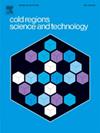Model test of in-situ remediation for heavy metal-contaminated clayey soil by artificial freezing and shaft washing
IF 3.8
2区 工程技术
Q1 ENGINEERING, CIVIL
引用次数: 0
Abstract
The low permeability of clayey soil and the pressure of liquid extraction and injection tend to form preferential flow paths in the soil, diminishing the remediation efficiency of shaft washing. Therefore, a new in-situ repair method combining artificial freezing and shaft washing is proposed. Using Pb and Cd contaminated clayey soil as the research object, in-situ model tests of different eluent types, concentrations, and suction modes were conducted to investigate the removal rate of heavy metals and the distribution of temperature and water field. The results demonstrated that the artificial freezing method can effectively induce the water (eluent) migration from the unfrozen zone to the freezing front. Besides, it effectively resolved the issue of poor washing efficiency caused by preferential flow between the extraction and injection wells during the extraction process. After five freeze-thaw cycles, the removal rate of Pb and Cd reached 46.16 % and 59.04 %, respectively. The combination of artificial freezing and plastic drainage plate technology merges artificial freezing and shaft washing methods to achieve the remediation of heavy metal-contaminated soil, providing a reference for the in-situ remediation of heavy metal-contaminated clayey soil.
通过人工冻结和竖井冲洗对重金属污染粘性土壤进行原位修复的模型试验
粘土的低渗透性以及液体提取和注入的压力容易在土壤中形成优先流道,从而降低竖井冲洗的修复效率。因此,提出了一种结合人工冻结和竖井冲洗的新的原位修复方法。以铅和镉污染的粘性土壤为研究对象,进行了不同洗脱剂类型、浓度和抽吸模式的原位模型试验,研究了重金属的去除率以及温度和水场的分布。结果表明,人工冻结法能有效地促使水(洗脱液)从未冻结区迁移到冻结前沿。此外,它还有效地解决了萃取过程中萃取井和注入井之间的优先流导致的洗涤效率低下的问题。经过五个冻融循环后,铅和镉的去除率分别达到 46.16 % 和 59.04 %。人工冷冻与塑料排水板技术相结合,融合了人工冷冻与竖井冲洗方法,实现了重金属污染土壤的修复,为重金属污染粘性土壤的原位修复提供了参考。
本文章由计算机程序翻译,如有差异,请以英文原文为准。
求助全文
约1分钟内获得全文
求助全文
来源期刊

Cold Regions Science and Technology
工程技术-地球科学综合
CiteScore
7.40
自引率
12.20%
发文量
209
审稿时长
4.9 months
期刊介绍:
Cold Regions Science and Technology is an international journal dealing with the science and technical problems of cold environments in both the polar regions and more temperate locations. It includes fundamental aspects of cryospheric sciences which have applications for cold regions problems as well as engineering topics which relate to the cryosphere.
Emphasis is given to applied science with broad coverage of the physical and mechanical aspects of ice (including glaciers and sea ice), snow and snow avalanches, ice-water systems, ice-bonded soils and permafrost.
Relevant aspects of Earth science, materials science, offshore and river ice engineering are also of primary interest. These include icing of ships and structures as well as trafficability in cold environments. Technological advances for cold regions in research, development, and engineering practice are relevant to the journal. Theoretical papers must include a detailed discussion of the potential application of the theory to address cold regions problems. The journal serves a wide range of specialists, providing a medium for interdisciplinary communication and a convenient source of reference.
 求助内容:
求助内容: 应助结果提醒方式:
应助结果提醒方式:


